Case Study: Vino Pte Ltd - Finance Function Consolidation Analysis
VerifiedAdded on 2023/01/19
|12
|1031
|59
Case Study
AI Summary
This case study examines Vino Pte Ltd, a wine distributor in the Asia Pacific region, facing rising finance costs. The assignment involves reviewing the Accounts Payable (AP) process and designing a process flow to identify improvement opportunities. It analyzes the potential of consolidating finance functions into a Shared Service Center (SSC), comparing the costs and benefits of establishing the SSC in Malaysia versus China. The study includes a qualitative and quantitative analysis of factors like staff availability, government incentives, and staff costs. The proposed solution recommends setting up the SSC in Malaysia based on a better balance of qualitative and quantitative factors, along with suggestions for training programs to reduce associated costs. The analysis uses references from various academic sources to support the findings and recommendations.

VINO PTE LTD.
Paraphrase This Document
Need a fresh take? Get an instant paraphrase of this document with our AI Paraphraser

TASK 1:PROCESS DESIGN FOR AP PROCESS
• Invoice
• Approval
• requestor
1.Receive and check
invoice. Prepare
voucher and sign
invoice and send for
approval
2.Review and approve
invoices .Approv
e?
4. Submit to
AP Team
3.Follow up
with the
supplier to
rectify the
error
A
• Invoice
• Approval
• requestor
1.Receive and check
invoice. Prepare
voucher and sign
invoice and send for
approval
2.Review and approve
invoices .Approv
e?
4. Submit to
AP Team
3.Follow up
with the
supplier to
rectify the
error
A

TASK 1: PROCESS DESIGN FOR AP
PROCESS
• AP Staff
• Payment Officer
A Booking iparking
entriesnvoices,,che
cking and posting of
invoices
Passing invoices
AP Manage for
signng vouchers
Passing invoices to
payment officer for
final paymenr
PROCESS
• AP Staff
• Payment Officer
A Booking iparking
entriesnvoices,,che
cking and posting of
invoices
Passing invoices
AP Manage for
signng vouchers
Passing invoices to
payment officer for
final paymenr
⊘ This is a preview!⊘
Do you want full access?
Subscribe today to unlock all pages.

Trusted by 1+ million students worldwide

TASK 1: PROCESS DESIGN FOR AP PROCESS
• Payment Officer Receing invoices from AP
Manager,generate payment
proposal in SAP,Checking
the amount correction of
invoices
Amount payable
through cheque is
written and sent to
finance director and
second approval for the
signature in check
For electronic payment the file
uploaded to the HSBC web Bank and
Two approver by logging into the
same web approve the payment
• Payment Officer Receing invoices from AP
Manager,generate payment
proposal in SAP,Checking
the amount correction of
invoices
Amount payable
through cheque is
written and sent to
finance director and
second approval for the
signature in check
For electronic payment the file
uploaded to the HSBC web Bank and
Two approver by logging into the
same web approve the payment
Paraphrase This Document
Need a fresh take? Get an instant paraphrase of this document with our AI Paraphraser
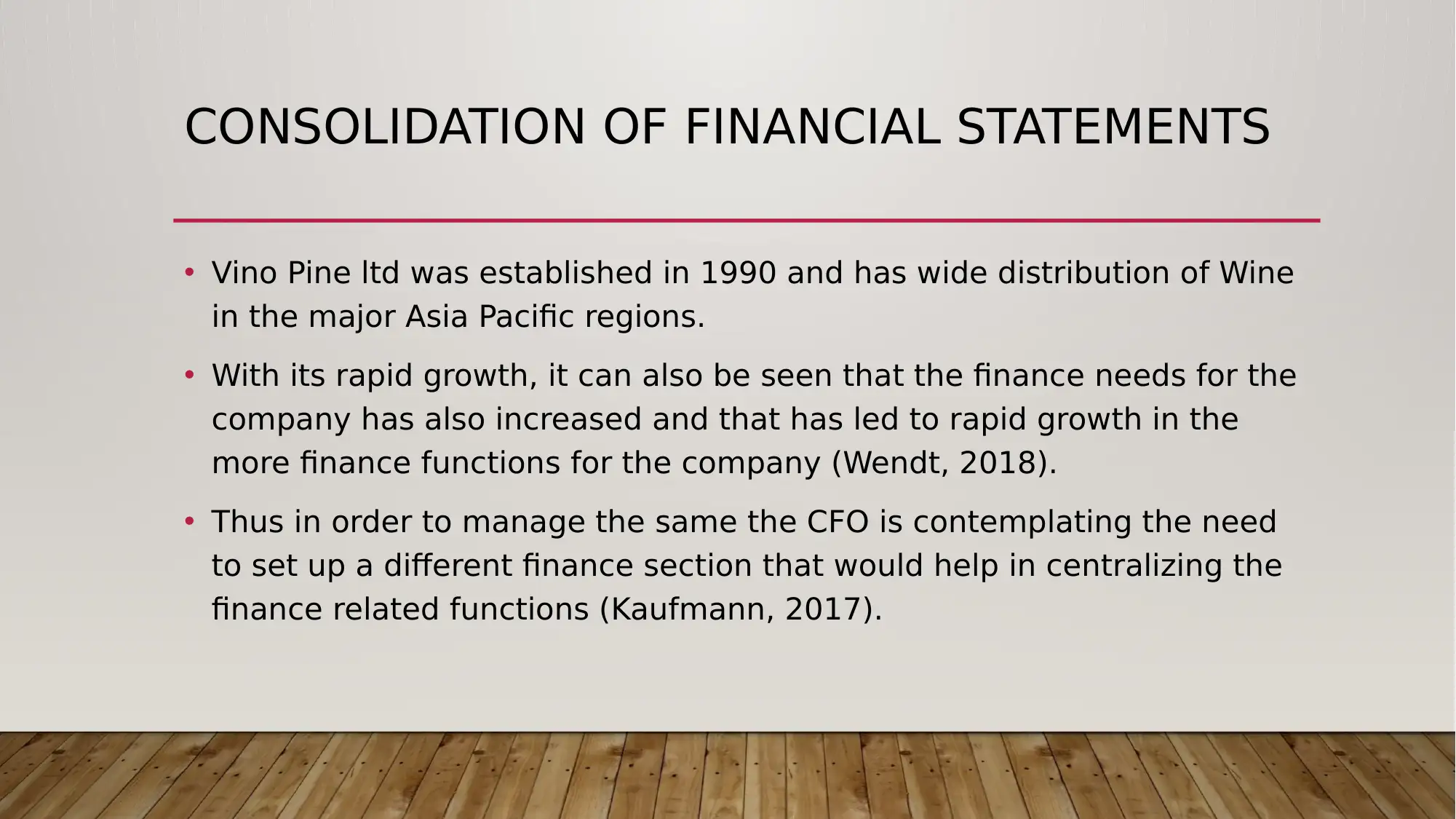
CONSOLIDATION OF FINANCIAL STATEMENTS
• Vino Pine ltd was established in 1990 and has wide distribution of Wine
in the major Asia Pacific regions.
• With its rapid growth, it can also be seen that the finance needs for the
company has also increased and that has led to rapid growth in the
more finance functions for the company (Wendt, 2018).
• Thus in order to manage the same the CFO is contemplating the need
to set up a different finance section that would help in centralizing the
finance related functions (Kaufmann, 2017).
• Vino Pine ltd was established in 1990 and has wide distribution of Wine
in the major Asia Pacific regions.
• With its rapid growth, it can also be seen that the finance needs for the
company has also increased and that has led to rapid growth in the
more finance functions for the company (Wendt, 2018).
• Thus in order to manage the same the CFO is contemplating the need
to set up a different finance section that would help in centralizing the
finance related functions (Kaufmann, 2017).
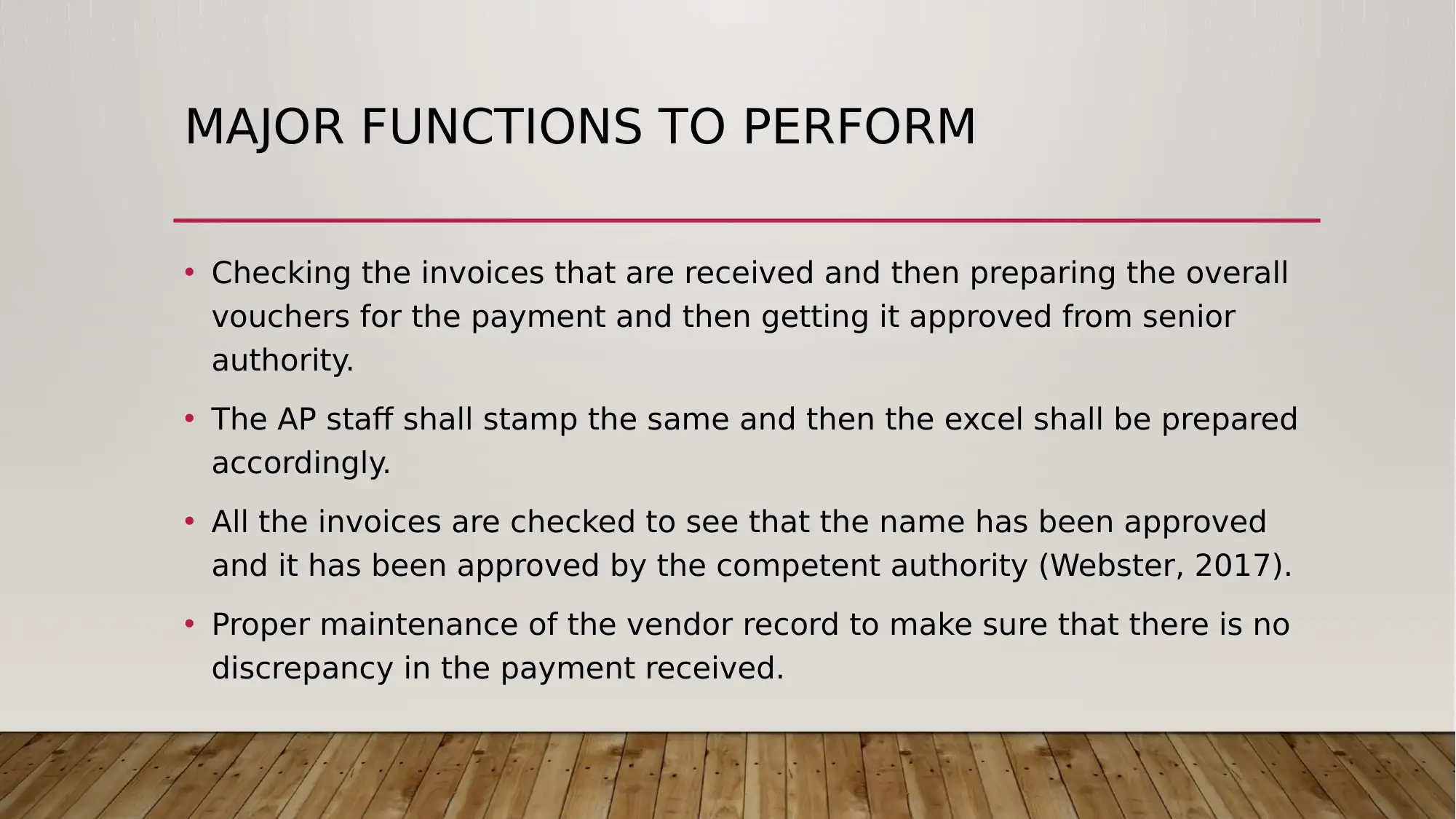
MAJOR FUNCTIONS TO PERFORM
• Checking the invoices that are received and then preparing the overall
vouchers for the payment and then getting it approved from senior
authority.
• The AP staff shall stamp the same and then the excel shall be prepared
accordingly.
• All the invoices are checked to see that the name has been approved
and it has been approved by the competent authority (Webster, 2017).
• Proper maintenance of the vendor record to make sure that there is no
discrepancy in the payment received.
• Checking the invoices that are received and then preparing the overall
vouchers for the payment and then getting it approved from senior
authority.
• The AP staff shall stamp the same and then the excel shall be prepared
accordingly.
• All the invoices are checked to see that the name has been approved
and it has been approved by the competent authority (Webster, 2017).
• Proper maintenance of the vendor record to make sure that there is no
discrepancy in the payment received.
⊘ This is a preview!⊘
Do you want full access?
Subscribe today to unlock all pages.

Trusted by 1+ million students worldwide

FUNCTIONS TO BE PERFORMED
• Booking the invoices on the SAP and making the necessary entries.
• Checking the accuracy of the invoices by passing them to appropriate
authorities.
• Payment officer shall check the accuracy of the payment through these
invoices.
• Finally the necessary signature in case of payment by cheque is to be
obtained and the same sort of approval to be obtained when the
payment is to released through the online mode (Truong, Partington
and Peat).
• Booking the invoices on the SAP and making the necessary entries.
• Checking the accuracy of the invoices by passing them to appropriate
authorities.
• Payment officer shall check the accuracy of the payment through these
invoices.
• Finally the necessary signature in case of payment by cheque is to be
obtained and the same sort of approval to be obtained when the
payment is to released through the online mode (Truong, Partington
and Peat).
Paraphrase This Document
Need a fresh take? Get an instant paraphrase of this document with our AI Paraphraser
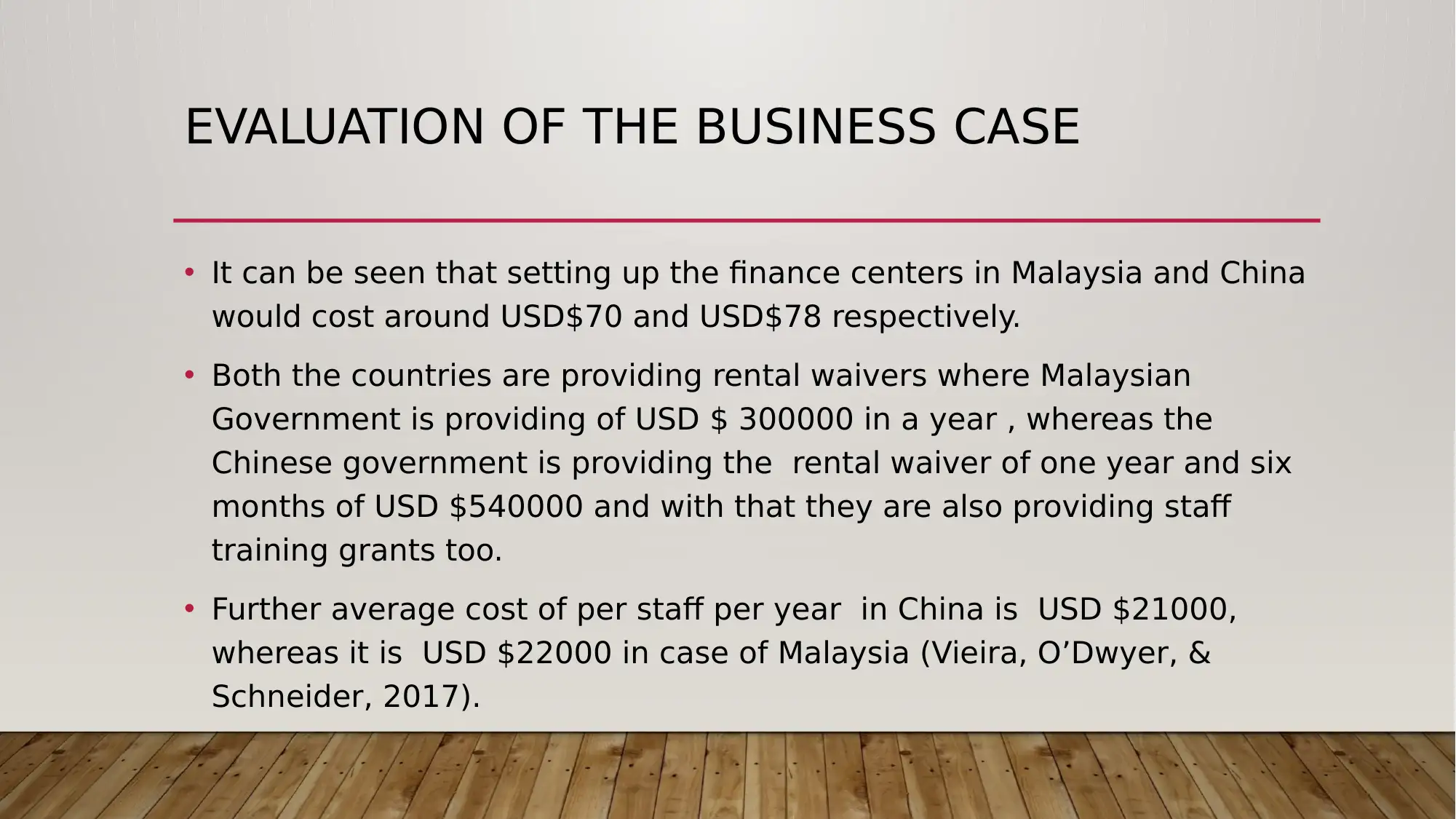
EVALUATION OF THE BUSINESS CASE
• It can be seen that setting up the finance centers in Malaysia and China
would cost around USD$70 and USD$78 respectively.
• Both the countries are providing rental waivers where Malaysian
Government is providing of USD $ 300000 in a year , whereas the
Chinese government is providing the rental waiver of one year and six
months of USD $540000 and with that they are also providing staff
training grants too.
• Further average cost of per staff per year in China is USD $21000,
whereas it is USD $22000 in case of Malaysia (Vieira, O’Dwyer, &
Schneider, 2017).
• It can be seen that setting up the finance centers in Malaysia and China
would cost around USD$70 and USD$78 respectively.
• Both the countries are providing rental waivers where Malaysian
Government is providing of USD $ 300000 in a year , whereas the
Chinese government is providing the rental waiver of one year and six
months of USD $540000 and with that they are also providing staff
training grants too.
• Further average cost of per staff per year in China is USD $21000,
whereas it is USD $22000 in case of Malaysia (Vieira, O’Dwyer, &
Schneider, 2017).
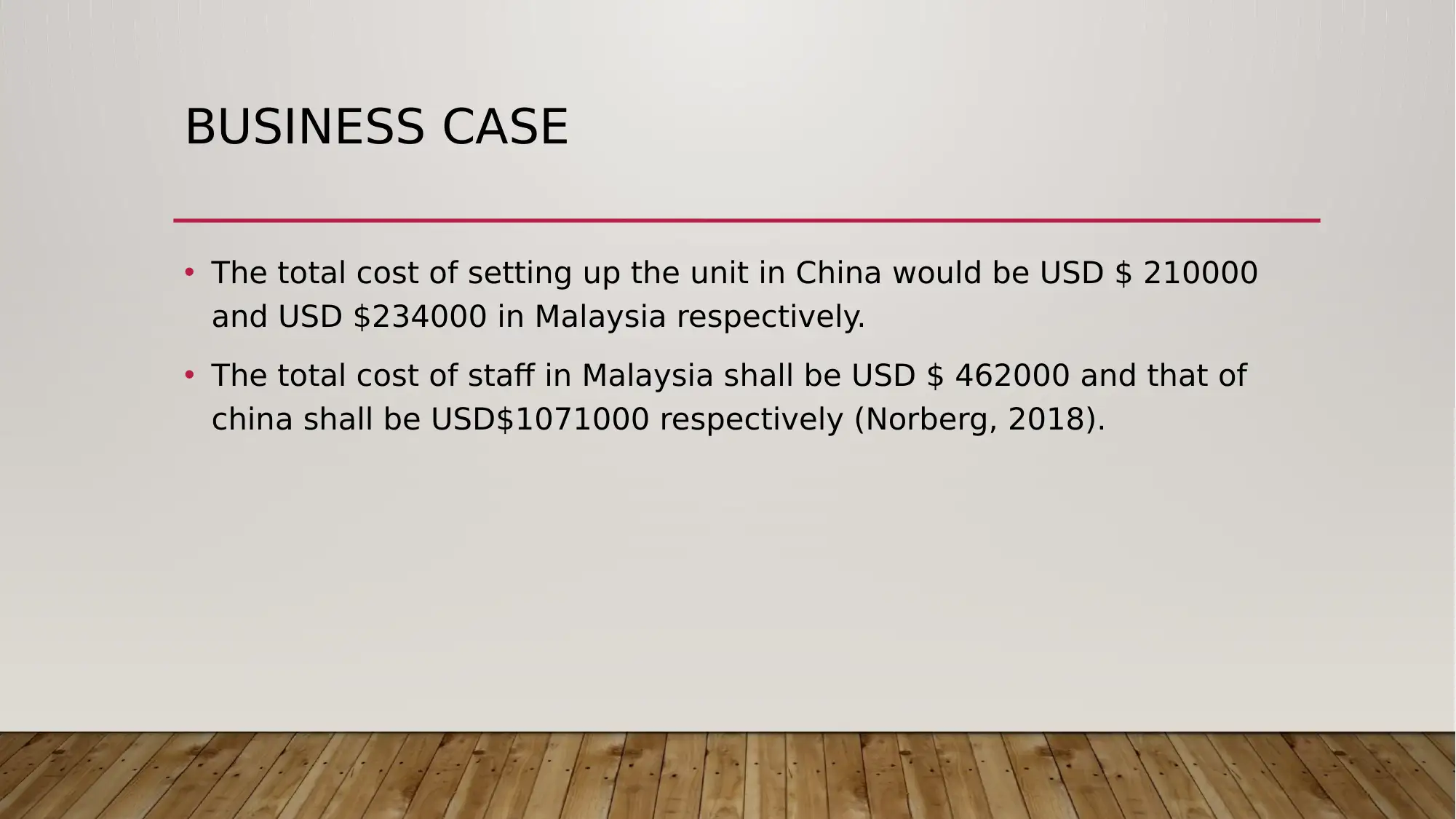
BUSINESS CASE
• The total cost of setting up the unit in China would be USD $ 210000
and USD $234000 in Malaysia respectively.
• The total cost of staff in Malaysia shall be USD $ 462000 and that of
china shall be USD$1071000 respectively (Norberg, 2018).
• The total cost of setting up the unit in China would be USD $ 210000
and USD $234000 in Malaysia respectively.
• The total cost of staff in Malaysia shall be USD $ 462000 and that of
china shall be USD$1071000 respectively (Norberg, 2018).
⊘ This is a preview!⊘
Do you want full access?
Subscribe today to unlock all pages.

Trusted by 1+ million students worldwide
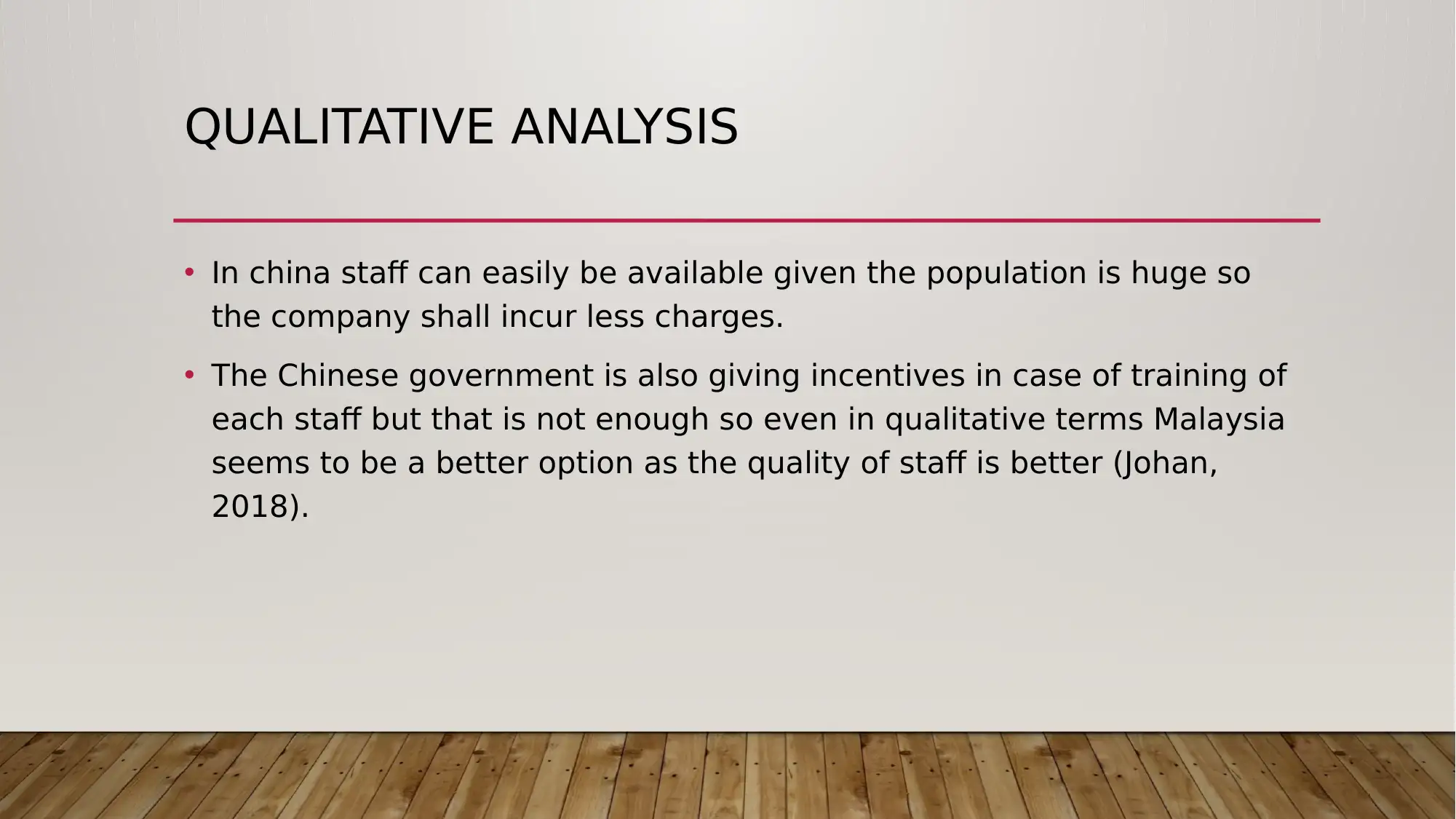
QUALITATIVE ANALYSIS
• In china staff can easily be available given the population is huge so
the company shall incur less charges.
• The Chinese government is also giving incentives in case of training of
each staff but that is not enough so even in qualitative terms Malaysia
seems to be a better option as the quality of staff is better (Johan,
2018).
• In china staff can easily be available given the population is huge so
the company shall incur less charges.
• The Chinese government is also giving incentives in case of training of
each staff but that is not enough so even in qualitative terms Malaysia
seems to be a better option as the quality of staff is better (Johan,
2018).
Paraphrase This Document
Need a fresh take? Get an instant paraphrase of this document with our AI Paraphraser
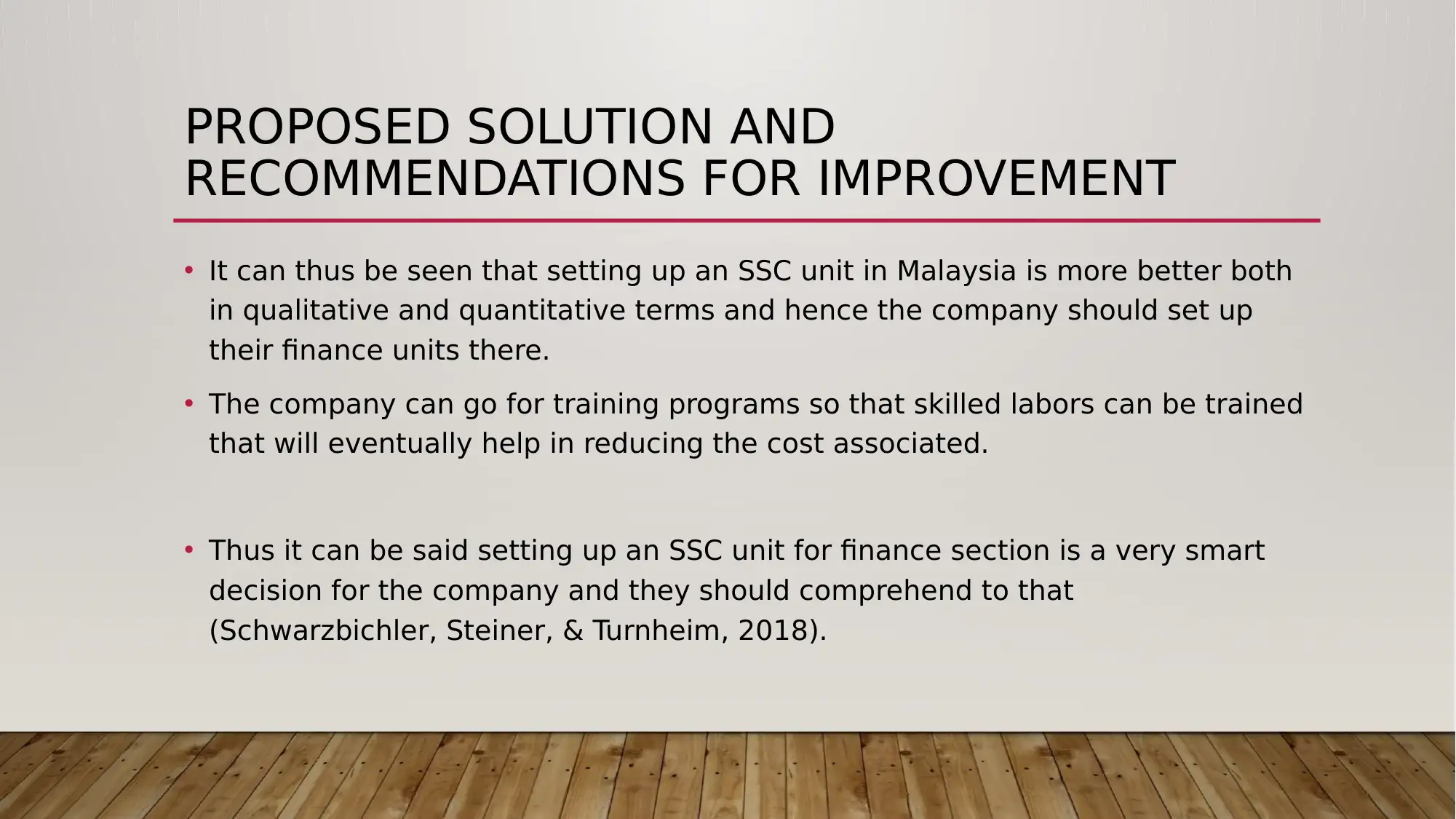
PROPOSED SOLUTION AND
RECOMMENDATIONS FOR IMPROVEMENT
• It can thus be seen that setting up an SSC unit in Malaysia is more better both
in qualitative and quantitative terms and hence the company should set up
their finance units there.
• The company can go for training programs so that skilled labors can be trained
that will eventually help in reducing the cost associated.
• Thus it can be said setting up an SSC unit for finance section is a very smart
decision for the company and they should comprehend to that
(Schwarzbichler, Steiner, & Turnheim, 2018).
RECOMMENDATIONS FOR IMPROVEMENT
• It can thus be seen that setting up an SSC unit in Malaysia is more better both
in qualitative and quantitative terms and hence the company should set up
their finance units there.
• The company can go for training programs so that skilled labors can be trained
that will eventually help in reducing the cost associated.
• Thus it can be said setting up an SSC unit for finance section is a very smart
decision for the company and they should comprehend to that
(Schwarzbichler, Steiner, & Turnheim, 2018).

REFERENCES
• Johan, S. (2018). The Relationship Between Economic Value Added, Market Value Added And Return On Cost Of
Capital In Measuring Corporate Performance. Jurnal Manajemen Bisnis dan Kewirausahaan, 3(1), 121-134.
• Kaufmann, W. (2017). The Problem of Regulatory Unreasonableness (First ed.). New York: Routledge.
• Norberg, P. (2018). Bankers Bashing Back: Amoral CSR Justifications. Journal of Business Ethics, 147(2), 401-418.
• Schwarzbichler, M., Steiner, C., & Turnheim, D. (2018). Impairment of Assets (Fixed Assets and Goodwill) (first
ed.). New York: Springer Publication.
• Vieira, R., O’Dwyer, B., & Schneider, R. (2017). Aligning Strategy and Performance Management Systems. SAGE
Journals, 30(1), 23-48.
• Webster, T. (2017). Successful Ethical Decision-Making Practices from the Professional Accountants' Perspective.
ProQuest Dissertations Publishing, 3(1), 142-156.
• Wendt, K. (2018). Positive Impact Investing: A Sustainable Bridge between Strategy, Innovation, Change and
Learning (first ed.). Switzerland: Springer.
• Johan, S. (2018). The Relationship Between Economic Value Added, Market Value Added And Return On Cost Of
Capital In Measuring Corporate Performance. Jurnal Manajemen Bisnis dan Kewirausahaan, 3(1), 121-134.
• Kaufmann, W. (2017). The Problem of Regulatory Unreasonableness (First ed.). New York: Routledge.
• Norberg, P. (2018). Bankers Bashing Back: Amoral CSR Justifications. Journal of Business Ethics, 147(2), 401-418.
• Schwarzbichler, M., Steiner, C., & Turnheim, D. (2018). Impairment of Assets (Fixed Assets and Goodwill) (first
ed.). New York: Springer Publication.
• Vieira, R., O’Dwyer, B., & Schneider, R. (2017). Aligning Strategy and Performance Management Systems. SAGE
Journals, 30(1), 23-48.
• Webster, T. (2017). Successful Ethical Decision-Making Practices from the Professional Accountants' Perspective.
ProQuest Dissertations Publishing, 3(1), 142-156.
• Wendt, K. (2018). Positive Impact Investing: A Sustainable Bridge between Strategy, Innovation, Change and
Learning (first ed.). Switzerland: Springer.
⊘ This is a preview!⊘
Do you want full access?
Subscribe today to unlock all pages.

Trusted by 1+ million students worldwide
1 out of 12
Your All-in-One AI-Powered Toolkit for Academic Success.
+13062052269
info@desklib.com
Available 24*7 on WhatsApp / Email
![[object Object]](/_next/static/media/star-bottom.7253800d.svg)
Unlock your academic potential
Copyright © 2020–2025 A2Z Services. All Rights Reserved. Developed and managed by ZUCOL.
